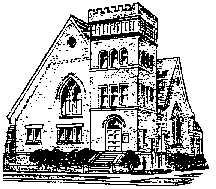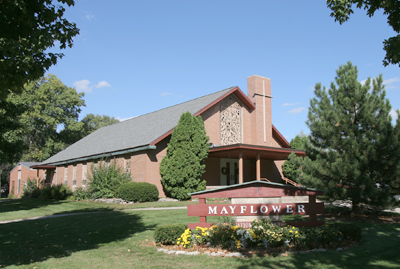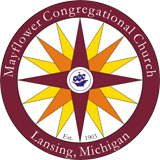 |
Founded 1903 Mayflower Congregational Church began as a congregational church more than a hundred years ago in 1903 on the south side of Lansing at what was then the corner of Logan (now MLK Jr. Blvd.) and St. Joseph Streets.
|
 |
Expansion, 1915 A new building was constructed across the street from the original building. It was dedicated on September 5, 1915. |
 |
Relocation, 1959 - present Mayflower moved to its present location at the corner of 2901 W. Mt. Hope Avenue and Lewton on June 14, 1959. Located in a pleasant neighborhood, Mayflower Congregational Church offers many opportunities... so come check us out!
|
 Current location at 2901 W. Mt. Hope Ave. Viewed from the front of the church at the corner of Belaire and Lewton.
Current location at 2901 W. Mt. Hope Ave. Viewed from the front of the church at the corner of Belaire and Lewton.
The History of the Congregational Church...
The Congregational way is a way of following Christ. People of a Congregational Church do not seek to be led by a creed, but by the Spirit. Ours is the tradition of a free church, gathered under the headship of Christ and bound to others by love, not law.
When King Henry VIII of England broke with Rome and made the Church of England subservient to the English crown, many of his subjects thought he had not gone far enough in reforming the church. These people, sometimes called Puritans, wanted a church that was thoroughly reformed in its worship, governance, and outlook.
Some of them tried to purify the English Church from within. Others, known as Separatists, left the state church and formed local groups of believers bound together by mutual covenants. They found warrant for these gathered churches in Matthew 18:20, which says, "for where two or three come together in my name, there am I with them."
One of these churches was gathered by covenant in the village of Scrooby in 1606. They met on Sundays in the home of the postmaster, William Brewster, for Bible study and prayer. Such gatherings were banned by British law, which demanded that all subjects of the king belong to the Church of England and no other. When the threat of persecution by English authorities became severe, the little church of Scrooby, led by its pastor John Robinson, fled to Holland.
After a few peaceful and prosperous years in Leiden, the Scrooby congregation made plans to establish a Separatist colony in America. Sailing on the Mayflower from the port of Plymouth, England, in 1620, the 102 voyagers arrived off Cape Cod in late autumn and landed in a harbor they named Plymouth. Before stepping ashore, they drafted an agreement as the basis for the civil government of their colony. This Mayflower Compact was the first written expression in history of a social contract, in which the people agree among themselves to form the state. It can be seen as a civil counterpart to the covenant by which they had formed their church in Scrooby.
These people have been called Pilgrims by later generations of Americans. Their first winter on American soil was very hard, claiming the lives of half the group. But under the leadership of able governors such as William Bradford, the colony at Plymouth soon prospered.
In 1629 and 1630, the Pilgrims of Plymouth were joined by a much larger migration of Puritans from England, who founded the city of Boston and other towns and villages which together made up the Massachusetts Bay Colony. These newcomers, led by Governor John Winthrop, were better financed and more numerous than the Pilgrims of Plymouth, and they soon dominated the civil and religious life of Massachusetts and the other New England colonies.
Unlike the settlers of Plymouth, most of the Massachusetts Bay party were non-Separatists. They were Puritans who did not necessarily want to separate from the Church of England. Nevertheless, persecution at home had driven them to a physical, if not a spiritual, separation.
Most importantly, the non-Separating Puritans who came to Massachusetts formed their churches in the same way the Scrooby Separatists had formed theirs: by covenanting together, without the aid of king, bishop, or synod. Thus, in the decades that followed, New England became filled with Congregational churches.
Boston eventually had several such churches, but each frontier settlement of any size had its own church. Each church hired its own pastor and ran its own affairs. Periodically, lay and clergy representatives of these churches would meet to discuss matters of common concern -- but any conclusions reached were advisory, not mandatory upon the churches. Only the congregation could decide matters for the local church.
The original Congregationalists were strict Calvinists, who espoused a covenantal theology. Ensuing generations began to fall away from the particular tenets of this belief, until, in the early 1700s, New England was ripe for the first religious revival movement on American soil. This Great Awakening was led primarily by Jonathan Edwards of Northampton, Massachusetts, who worked with spiritual and intellectual distinction over the course of a long life to support the tenets of the original New England theology.
Also in the eighteenth century, the tradition of freedom and self-government started by the Congregationalists of New England fostered the spirit of independence which informed the American revolutionaries. Many small New England churches participated actively in the War of Independence.
By the 1800s, as the effects of the Great Awakening began to recede, many were turning to more liberal theologies. A great controversy arose in which many of the old First Churches of New England became Unitarian.
Nevertheless, the Congregational churches went on, joining with the Presbyterians in a Plan of Union for the purpose of joint missionary endeavors on the western frontiers. The Congregationalists pulled out of this Plan of Union later, when fifty years' experience showed its effect had been the building of a large number of Presbyterian, not Congregational, churches in the western states.
During the late nineteenth and early twentieth centuries, many of the Congregational churches in the United States, which had resisted the Unitarian impulse, nevertheless became more liberal in their theological outlook. No Congregational church could impose a particular creed on its members. But the members, in general, came to see Christianity in a different light: They interpreted the Bible less literally than their ancestors did, and they began to re-adopt some previously discarded worship practices of the more liturgical churches.
At the same time, Congregationalists often led in Christian social activism. They championed the abolition of slavery, the elevation of women's status -- a Congregationalist, Antoinette Brown, was the first woman ordained to the Christian ministry in America-- and the new "social Gospel" movement of the later years. The Social Gospel, championed by the Congregational minister Washington Gladden and the Baptist Walter Rauschenbusch, attempted to get Christians to embrace the struggles and relieve the difficulties of impoverished urban laborers.
The early twentieth century was a time of mergers. The Congregational churches had formed a national body, the National Council of Congregational Churches. In 1931, this National Council merged with the General Convention of the Christian Church to form the General Council of Congregational Christian Churches. (The Christians were a group of churches operating on principles almost identical to those of the Congregationalists, but laying more importance on the use of the name Christian to identify followers of Christ.) This merger was accomplished smoothly and with little dissent.
A few years later, another merger was proposed: Churches of the General Council would merge with the Evangelical and Reformed Church, a group of mainly German heritage which had theological affinities with many Congregationalists but did not accept the autonomy of the local congregation, which had always been the distinctive feature of Congregationalism.
This merger was eventually completed, to form the United Church of Christ. But about 200 Congregational Christian churches chose not to join the merger, mainly on the issue of congregational polity. The National Association of Congregational Christian Churches was formed in 1955 to give those congregations a national fellowship which would not threaten the freedom of each congregation.
(Resource: NACCC)
Mayflower Church - Come Grow with Us!
